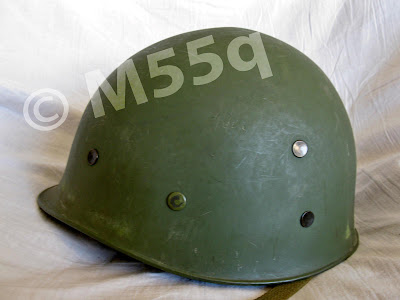Danish M48 clone helmet - made in 1965 by USCH
Medic helmet cover from 1963
------------------------------------------------------------------------------------------------
In the first years after WWII, the Danish army used three main types of helmets. The British "turtle" helmet + the Mk II and the Swedish M/37. We tried to produce our own helmet, the M/46, however the Danish army decided to introduce the American M1 helmet instead. It was cheap and well made. It remained the standard combat headgear in the Danish army until 1992 when the first kevlar helmet, produced by Schubert in Germany, and the first flak jacket was introduced.
The M1's were in the beginning surplus WWII helmets. A small Danish production run was begun in 1957. These helmets were made of magnetic steel, and came with a Bakelite liner. All of them went to the civil defence, since they were deemed unusable by the army. In 1965 the Danish army received the first German and Austrian produced M1 clones. These helmets are known as the M/48-65.
The Danish M1 clones were produced by:
Austria: Heinrich Ulbricht's Witwe, Schwanenstadt (stamp: U.SCH)
Germany: Linnemann Schnatzer, Ahlen (stamp: LS)
Germany: Busch Vereinigten Deutsche Nickelwerke AG Schwerte (stamp: VDN)
In the beginning the helmet liner were the old "resin" ones, but later, the old WWII helmets and clones were given a hard plastic liner produced from 1963 in Denmark by Dansk Kunststof Industri - DKI. They were of a higher quality that did not dissolve in the humid Danish weather like the resin ones. They liners were made of fibreglass impregnated with coloured polystyrene, and were made in three different colours: Green (army), grey (civil defence) and blue (navy). Later DKI produced a high visibility orange liner for the Civil defence. The liners were able cope with temperatures ranging from -30 to +40 degrees Celsius. DKI also sold the same helmet liner to the Norwegians, when they introduced the M1 helmet, as the M/58.
The helmets were usually used together with a cotton helmet net. The net was very similar to the US M/44 net. All webbing parts were in a olive green shade, and all metal work on buckles etc were kept in brass. The helmets were made of a non-magnetic metal, the so called Mangalloy because of its high impact strength and resistance to abrasion. - WIKI: Mangalloy
If you want additional information on the M1 helmets, visit Mannie's blog.
http://www.combathelmets.blogspot.com/
-------------------------------------------------------------------------------------------------
First helmet is a M1 -Front seam helmet made by McCord Radiators late in the war - late 1940s.
Heat stamp: 926A
Liner is of the 1963 DKI type, and the chinstraps are made of cotton webbing.
Colour: "apple green"
Buckles: Brass.
-------------------------------------------
Austrian clone shell made by USCH in 1965
Same type of liner, made by DKI.
Webbing straps on the liner is a cotton / nylon mix.
The chinstrap on the shell is the US M/73, with chin cup. It is made out of nylon and cotton webbing.




















do you think if you got a Vietnam us cover it could pas as an m1?
ReplyDeleteYou can't fool the seasoned collector, but for "re-enacting" and "playing around" it should pass just fine as a M1. It is almost the same shape and size as the real M1's. (and much more affordable)
DeleteYou can see how a clone compares to a real M1 in the blog entry above. The apple green is a WWII / Korean war M1 and the OD green helmet with textured finish is a clone. They are almost identical.
I am still fascinated by these Danish M1 versions. Do you have photographs of the original Danish liner? Is it the red - or reddish-brown - one which has a distinctive smell?
ReplyDeleteAnd do those Danish-made shells have any particular characteristic apart form being magnetic? Were there any Danish-made shells which were NOT magnetic?
Yes, I do have several pictures of original Danish liners, since I am the happy owner of one.
DeleteThe liner is reddish brown, made of "Bakelite" or Bakelite like material, with grey webbing suspension and painted grey on the outside. Obviously made for a CF helmet. (Civilforsvaret)
All Danish helmets, prior to the use of the British, US and later German produced M1 clones are magnetic. The M23 family of helmets, The M49 and M1 clones. (Obviously the M39 police helmet is magnetic)
There is a number of characteristics that tell Danish M1 clones from the later German and original M1 helmets. Might be a god idea to cover in a future post.